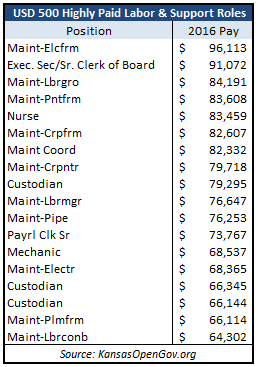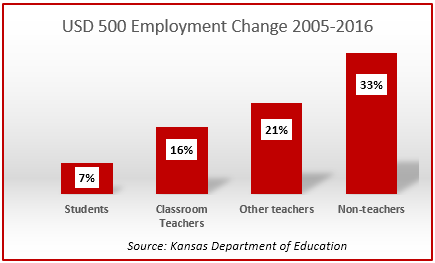KCTV 5 and reporter Caroline Sweeney essentially served as the public relations arm of the Kansas City, Kansas, School District on April 18. The reporter spoke to lobbyists–and apparently no one else–to craft a tall tale about the state of USD 500’s finances.
In ironic fashion, Sweeney called her story, “Bad Math,” and then failed to check the facts before the package hit the airwaves. Per-pupil operating spending increased and enrollment is declining – completely opposite the message conveyed in the story.
Sweeney said block grants kept funding stagnant and compared current funding to 2014 (the year before block grants) but didn’t disclose that funding actually increased in 2015. The story said the district had gained students over the life of the block grants, but that’s not true. USD 500 full time equivalent enrollment peaked at 20,523 students in 2015, before sliding to 20,518 in 2016 and is budgeted at 20,405 this year. KSDE has not published 2017 audited enrollment data on its web site as of today.

The district did see per-pupil spending decline since 2015, but that was due to a conscious choice by the school board to spend $28.7 million less on Capital Outlay. KCK’s operating expenses per pupil are budgeted to increase during the so-called lean years of block grant funding. In 2014, USD 500 spent $13,971 in operating expenses per pupil. In 2017, they budgeted to spend $14,570 in operating expenses per pupil.
Sweeney said classroom sizes in USD 500 grew during block grant funding, attributing bigger class sizes to state legislative decision. This is disingenuous at best.
If class sizes did increase, it was by choice of the local school board. They could have used a portion of the $67 million in operating cash reserves with which they began this school year to hire more teachers; $42 million of that money represents revenue collected but not spent since 2005.
Classroom size is a local management decision and NOT a legislative one. The school board could also have chosen to reduce its out-sized management staff (they’d have 26% fewer managers at Shawnee Mission’s student-per-manager ratio) or eliminate perhaps the only Superintendent’s Chief of Staff in Kansas; David Smith collected $134,689 last year and was listed as Chief of Staff on Open Records data until last year, when his title was changed to “Adm Staff.” Smith features prominently in Sweeney’s fish story and is a registered lobbyist for USD 500. The district could possibly hire three more teachers without that one position.
They might also have followed the recommendations of 
a state efficiency audit that showed maintenance and other staff are paid 20 percent to 30 percent above market wages. But their payroll still shows an Electrician Foreman at $96,113…an Executive Secretary/Board Clerk over $91,000…and multiple maintenance workers collecting between $70,000 and $85,000. They even have two custodians who are paid $66,000 and one at nearly $80,000.
In reality, student-teacher ratios in KCK improved over the last decade. In 2005, KCK had 15.7 students per classroom teacher. Last year, there were 14.6 students per classroom teacher at USD 500. The ratio declined because teacher employment grew much faster than the enrollment increase.
With just a 7 percent increase in full time equivalent students between 2005 and 2016, USD 500 added 16 percent more classroom teachers, 21 percent more Special Education teachers and Reading Specialists and a whopping 33 percent more non-teachers.
Despite all of these options, David Smith told KCTV 5, “All of this has made it incredibly difficult to try to balance the money we have with all of what we want to do for our students.” This is the same district that spent $47,000 on a grand piano in the midst of block grant funding.
Sweeney also spoke to the President of the KCK Kansas National Education Association but if she spoke to school funding experts able to refute the district’s claims, there was no evidence of it in the story. KCTV 5 did get a quote from the Governor’s office.
The Sentinel asked the station if they were willing to run a correction, since they were obviously hoodwinked by the USD 500. KCTV 5’s news desk person, Tim (who refused to give his last name), said reporters gather a lot of information that doesn’t end up on air. “Of course we always cover both sides,” Tim said.
Sweeney said she’s sent the information provided by The Sentinel to her news editor for consideration.
Kansans are attempting to have a serious debate about school funding, and this affront to journalism makes a reasonable discussion more difficult. Legislators face a self-imposed and a Kansas Supreme Court-imposed deadline of June 30 to adopt a new school funding formula.
KCTV 5’s propaganda masquerading as reporting is a sham, and KCTV 5’s viewers deserve better.



